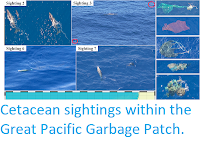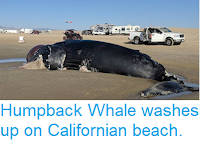A juvenile Blue Whale, Balaenoptera musculus, has been found on the coast of Nova Scotia. The Whale, judged to be a juvenile as it is only 18.8 m in length (compared to around 30 m for adults of the species) was first sighted Sutherland's Cove, about six kilometres north of Port Hawkesbury on Wednesday 18 September 2019. It was originally hoped that a necropsy (animal autopsy) could be performed on the Whale, as there have been concerns about Whales in the area being injured or killed by ship strikes or after becoming entangled in abandoned fishing nets, but Fisheries and Oceans Canada have now ruled this out, due to the remote location of the corpse and its advanced state of decay.
The body of an immature Blue Whale found at Sutherland's Cove on the coast of Nova Scotia on 18 September 2019. Carol Morris/The Chronicle Herald.
Blue Whales are the largest animals living on Earth
today, and are larger than any known animal in the fossil record, with
adults reaching around 30 m in length (some Sauropod Dinosaurs are
thought to have been slightly longer, but much less bulky). The species
was hunted to the brink of extinction during the twentieth century,
before a moratorium on hunting the species was introduced in 1966, since when the species has begun to recover. There are
currently thought to be somewhere between 10 000 and 25 000 Blue Wales
living today, with the species being classified as Endangered under the
terms of the International Union for the Conservation of Nature’s Red List of Threatened Species.
See also...
Follow Sciency Thoughts on
Facebook.







